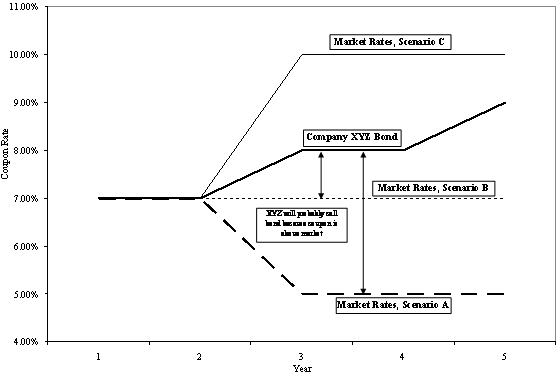What are Step-Up Bonds?
A step-up bond is a bond with a coupon that increases ('steps up'), usually at regular intervals, while the bond is outstanding. Step-up bonds are often issued by government agencies.
How Do Step-Up Bonds Work?
Let's consider a five-year step-up bond issued by Company XYZ. The coupon rate might be 7% for the first two years, increasing to 8% for years three and four, and 9% in the fifth year. The initial coupon rate on a step-up bond is usually above market.
Many step-up bonds are callable, which gives issuers some protection against falling interest rates. For example, if after three years the XYZ bond is paying 8% but market rates are down to 5% (Scenario A), Company XYZ would be paying a relatively high interest rate on its debt. It would probably call the bonds and reissue the debt at a lower rate. In fact, if rates simply stay the same (Scenario B), Company XYZ will probably call the bond. Conversely, if market rates rise to 10% (Scenario C) and Company XYZ pays only 8% for its debt, then the firm will have a favorable cost of debt.

There are several advantages to step-up bonds: They offer coupon payments that somewhat offset inflation, they usually come from high-quality issuers, and they are fairly liquid. Another advantage is that step-up bonds lessen the interest-rate risk for the investor because increasing rates provide a better yield (as long as the bond is not called).
Some investors view step-up bonds as buy-and-hold investments because they are less sensitive to interest rate changes than traditional bonds are. If rates rise, for example, the prices of step-up bonds don't fall as much as a similar noncallable bond (this is because of future increases in the coupon rate). If rates fall, the price of a similar noncallable bond tends to increase more than the step-up's price.
Why Do Step-Up Bonds Matter?
The promise of higher future coupon payments provides a way for income investors to earn increasingly higher yields on their holdings. However, the callable nature of most step-up bonds means that those returns can be elusive -- the high rates promised in later years will not materialize if the issuer calls the bonds.
It is important to note that callable step-ups have more call risk than traditional callable bonds. This is because, as we saw in the above example, issuers of step-up bonds often call their bonds even if interest rates simply stay flat. Issuers of traditional callable bonds, on the other hand, typically don't call their bonds unless rates go up. Essentially, investors can count on their step-up bonds being called unless interest rates rise higher and faster than the coupon rate on those bonds. For this reason, step-up bonds are more attractive when rates are expected to rise quickly and to a level above the step-up rates. This, of course, requires research and some speculation on the investor's part.



